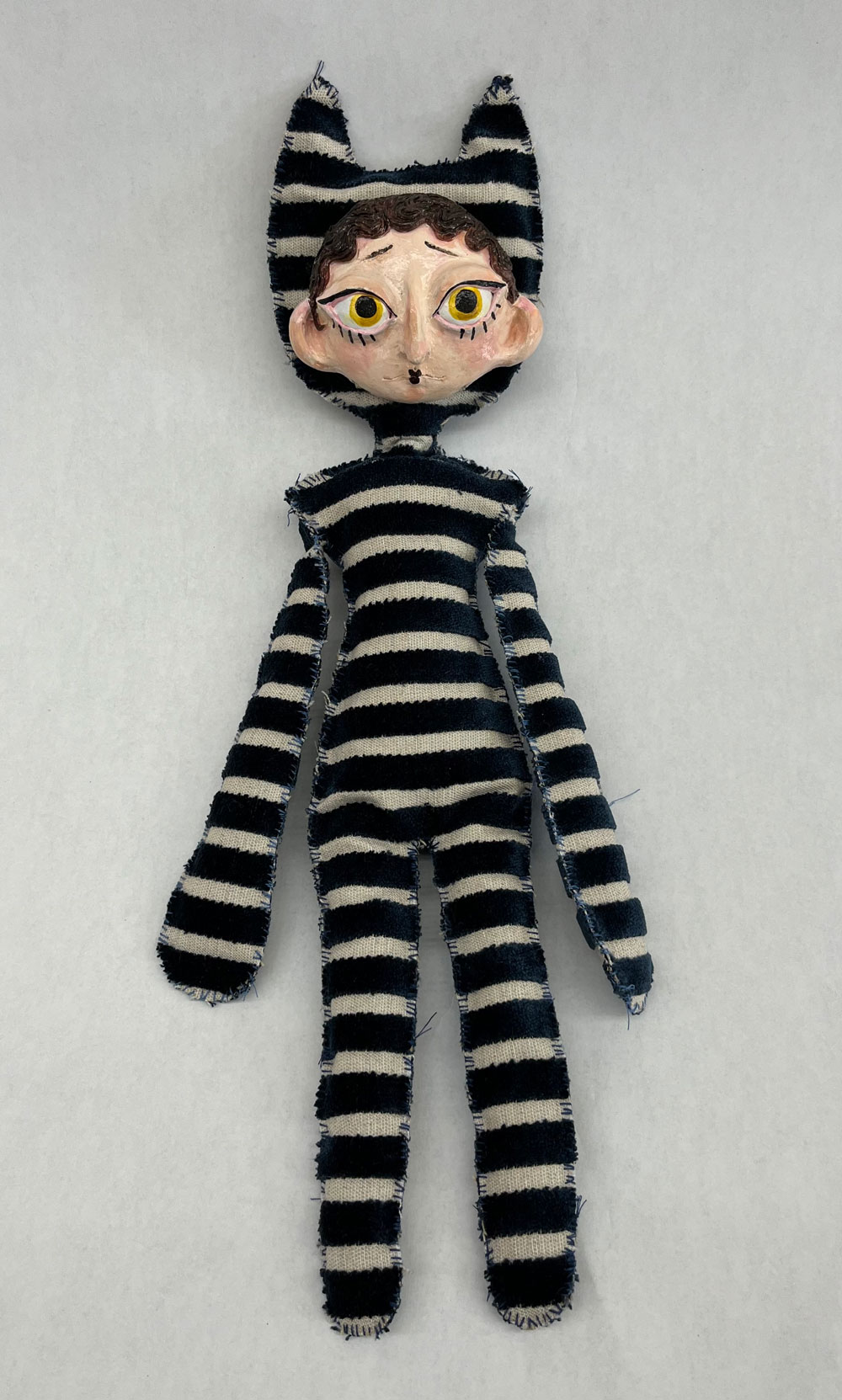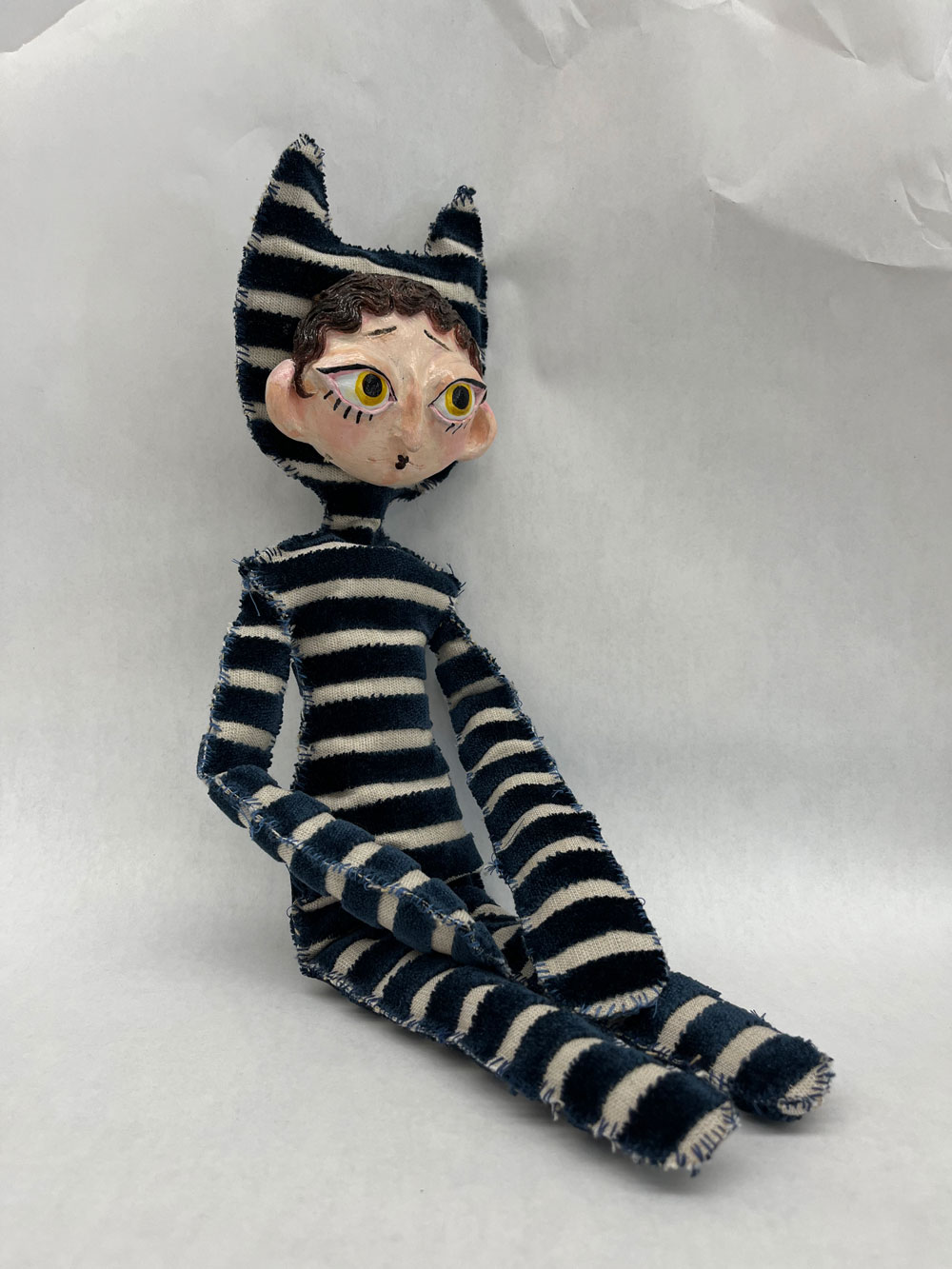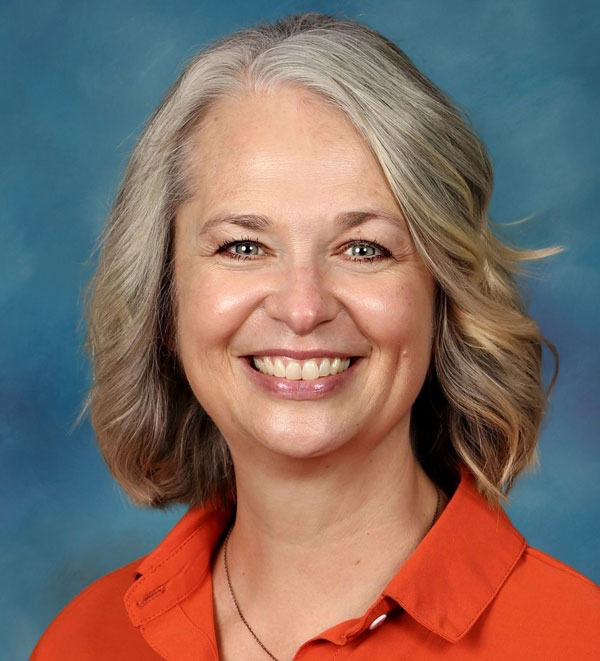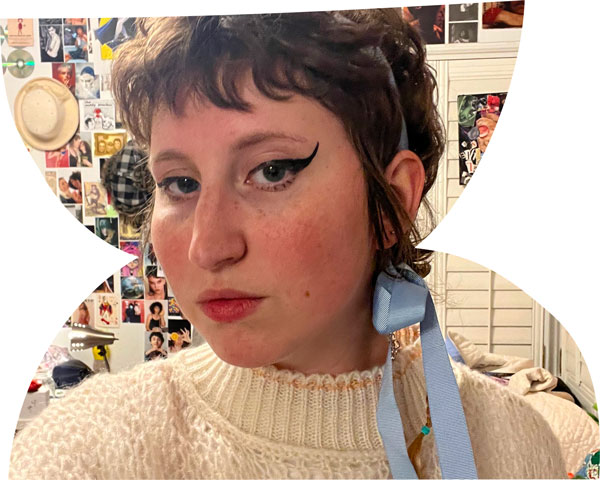

Kisa

Height: 18" x Width: 4' x Depth: 2" | Material(s): Polymer clay, acrylic paint, fabric, thread, and needle | Process(es): Reenvisioned previous work, but created the work to be more conventionally beautiful | Idea(s): Revised work to be more traditionally beautiful when compared to the other doll that got negative reaction. | Curatorial Note: The clown doll personifies living outside the norms of society acceptance. The uncomplicated use of materials and combination of handmade forms create an effective way to express simplicity and clarity.
Arielle Gueorguiev
Student statement
Student statement
Does your work reference or draw on a contemporary or historical art-making style, practice, or tradition? If so, please explain.
The design is inspired by my mom’s toys that she played with growing up in the Soviet Union. The specific ones I’m inspired by are the animal plushies with rubber faces. When I was creating my own vision of this, I wanted to create a more elegant version, and it has a shape more similar to a sock monkey than the original creation.
How did this artwork relate to your sustained investigation inquiry?
The inquiry that guided my investigation is how people or things who don’t fit societal beauty standards are judged by their appearance and are often outcasts. It is an investigation of what society deems beautiful and what happens to those who don’t fit the mold. This specific work is a situation where I judged my mother’s childhood toys based on their appearance when I was younger. Now as I get older, I tend to find the beauty in unconventional things. I also tend to create most of my art with the intention of looking strange and nonhuman.
Describe how your inquiry evolved as your sustained investigation developed.
When I began my inquiry, it was mainly focused on clowns/harlequins and how people in the circus are only able to get jobs within those fields because they were laughed at for their differences. I began to think of all the beings judged for their physical appearance ranging from real to fantasy creatures. This led me to think about the overall attitude people have towards others who don’t fit into their standard of acceptability. After I developed this thought process, I began to create characters that had different features or that fit in different categories other than normal.

When I began my inquiry, it was mainly focused on clowns/harlequins and how people in the circus are only able to get jobs within those fields because they are laughed at for their differences.
How did you practice or improve your written inquiry statement as your portfolio developed?
I tried to be as concise as possible to be able to fit within the work limit. For the materials section, I described every material that I used in the process of making each work. For the process portion, I tried to relay my thought process and the themes I was trying to explore as well as the steps I took to create the work.
How did your school leadership (principal, assistant principal, guidance counselor, etc.) support your growth as an art student? This could be classroom visits, attending art shows, talking to you about your goals, etc.
My college counselor was very helpful with providing information on scholarships and college fairs that eventually helped discover the best college for me.
What is your advice to other AP Art and Design students?
My advice to AP Art students would be to always keep creating art. I also think that unconventional and nonrealistic art is still awesome art, and that you should not let systems or individuals think that your art is less than because it's unconventional.

Zuri Timmons
Art Teacher
Santa Susana High School, Simi Valley, CA, USA
Teacher statement
Teacher statement
How did you scaffold writing into the art-making and thinking processes?
For every project my students complete, they are required to submit preliminary notes and sketches, the final product, and a final written reflection. Then, students work with their assigned partner to critique each other's work both in writing and verbally. This has allowed me to seamlessly prepare students for the final portfolio exam as they work through their own reflection practices and peer feedback. By the end of the year, they have a strong collection of evidence of thoughtful planning and consideration of the meaning behind each art piece they create.
How did you support skill development AND inquiry in the AP Art and Design curriculum?
Each project that is assigned to students is based on a specific art concept with the goal of enhancing and building skills in that area. Some examples of project titles include Focal Point, Repetition, and Color and Emotion. As students read through the assignment brief and brainstorm, they are encouraged to consider how they could use this skill as a means of highlighting an aspect of their SI questions. In Arielle's featured work, she did a great job of combining juxtaposed textures with the idea of societal and cultural concepts of beauty vs. ugliness and being "other."
What creative programming (i.e., exhibit spaces, mentoring programs, curricular supports) have you implemented to support AP Art and Design students?
Each year around November, my AP Studio Art students host a formal gallery at the school. Students are prepared for the event with lessons on gallery etiquette, professionalism, and presentation. Each student has a table with four to six art pieces, and it is expected that they greet guests and are able to talk about what their SI is about and what their art means. This has been an incredibly successful event that builds confidence in the students and has consistently gotten very positive feedback from guests and community members. The aspect that people are usually the most impressed with is how much thought students put into their art and how eloquently they are able to speak about it!
Material(s): Procreate | Process(es): Created two dolls in the same style. First try: sewing machine. Second try: Hand sewn, different style. | Idea(s): Revised work to be more traditionally beautiful compared to the other doll that got negative reaction.
What did you learn from working with your student?
Arielle is a very free-spirited, out-of-the-box thinker. I, on the other hand, am more of a type A artist and teacher with my own ideas of organization and logic when it comes to art making. Working with Arielle showed me that there are infinite approaches to making art, and that it really pays off to allow students to pursue ideas that may feel uncertain at first. While timelines, content coverage, and preparation are important, it is also key to ensure that students are feeling connected to their work and have the space to be free in their own processes.
What is your advice to other AP Art and Design teachers?
My advice to other teachers would be to really enjoy the process and connect with students over their topics and artworks. AP Studio Art is one of my favorite classes to teach due to the fact that there is so much student choice, and it is wonderful to see the uniqueness of every student and where their ideas go. I have made lasting connections with previous AP students with whom I am still in contact with today. As an art teacher, I am in a very privileged position to both support the next generation of artists while also building relationships with them.

Aimee Spurbeck-Boian
Principal
Santa Susana High School, Simi Valley, CA, USA
Leader statement
Leader statement
What are you most proud of regarding your school’s AP Art and Design program, student, and teacher?
I am most proud of the freedom to create and explore new skills in the program, the student's persistence in working on her art, and the teacher's new techniques to expose students to variety.
What do you do to support visual arts programming in your school?
We look for ways to collaborate with other disciplines to utilize funding to expand programs.
What is your advice to other school leaders on how to support an AP Art and Design program?
Listen to teacher and student ideas and feedback to see how to make the program better.

Arielle Gueorguiev



